Business Legal Aspects: Detailed Analysis of LLP and Director Duties
VerifiedAdded on 2023/06/10
|12
|2743
|247
Report
AI Summary
This report provides a comprehensive overview of two key areas within business law: Limited Liability Partnerships (LLPs) and the duties of company directors. Task 1 focuses on LLPs, outlining their characteristics, legal framework under the Limited Liability Partnerships Act 2000, and the liabilities of partners. The report discusses the concept of separate legal entity, the taxation of LLPs, and the requirement for designated partners. Task 2 shifts the focus to company directors, analyzing their duties under the Companies Act 2006, specifically Sections 171 and 172. The report examines the scope of directors' powers, the proper purpose rule, and the significance of acting in the best interests of the company, considering relevant case law such as Hindle v John Cotton Ltd and Re Smith and Fawcett. The report concludes by summarizing the key characteristics of both LLPs and the duties of company directors.
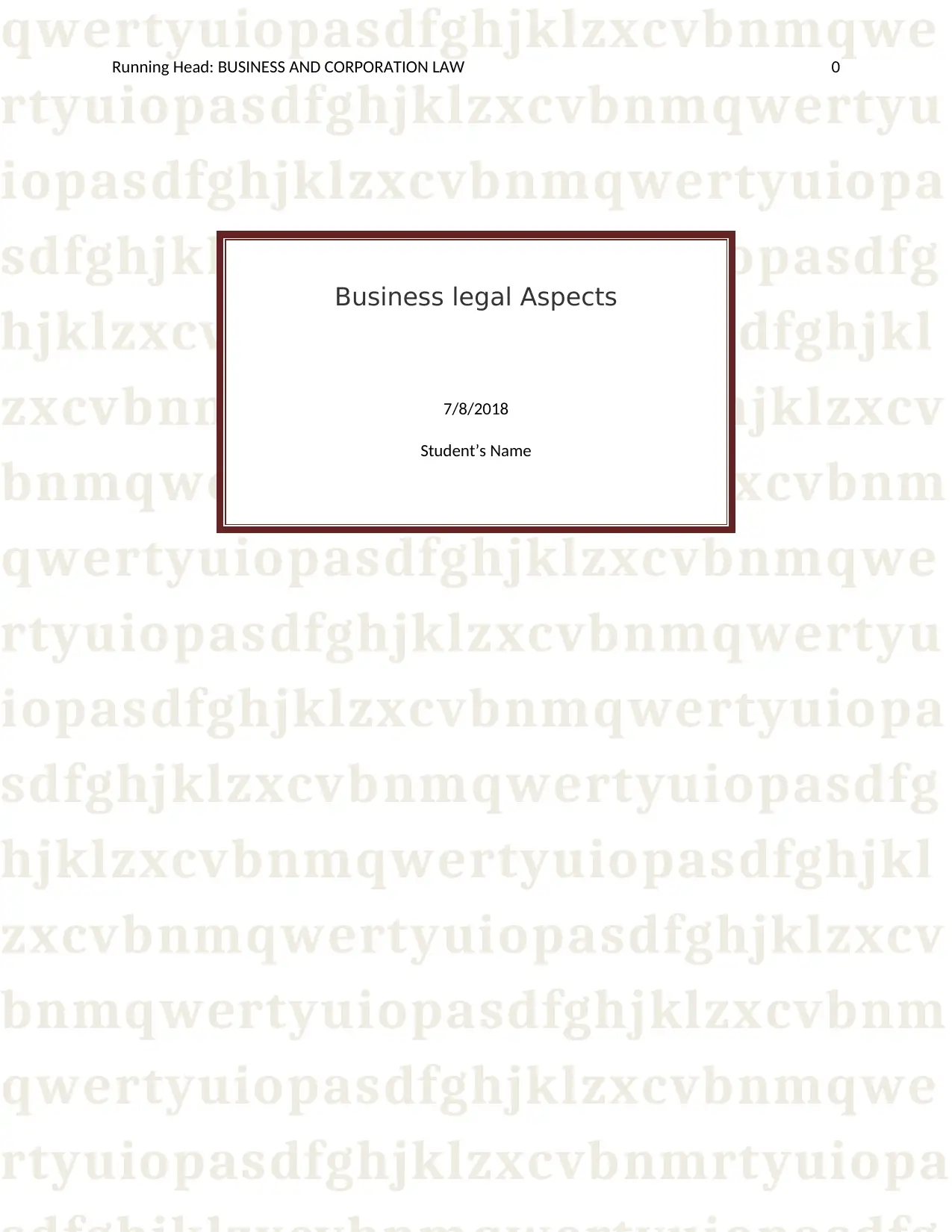
qwertyuiopasdfghjklzxcvbnmqwe
rtyuiopasdfghjklzxcvbnmqwertyu
iopasdfghjklzxcvbnmqwertyuiopa
sdfghjklzxcvbnmqwertyuiopasdfg
hjklzxcvbnmqwertyuiopasdfghjkl
zxcvbnmqwertyuiopasdfghjklzxcv
bnmqwertyuiopasdfghjklzxcvbnm
qwertyuiopasdfghjklzxcvbnmqwe
rtyuiopasdfghjklzxcvbnmqwertyu
iopasdfghjklzxcvbnmqwertyuiopa
sdfghjklzxcvbnmqwertyuiopasdfg
hjklzxcvbnmqwertyuiopasdfghjkl
zxcvbnmqwertyuiopasdfghjklzxcv
bnmqwertyuiopasdfghjklzxcvbnm
qwertyuiopasdfghjklzxcvbnmqwe
rtyuiopasdfghjklzxcvbnmrtyuiopa
Running Head: BUSINESS AND CORPORATION LAW 0
Business legal Aspects
7/8/2018
Student’s Name
rtyuiopasdfghjklzxcvbnmqwertyu
iopasdfghjklzxcvbnmqwertyuiopa
sdfghjklzxcvbnmqwertyuiopasdfg
hjklzxcvbnmqwertyuiopasdfghjkl
zxcvbnmqwertyuiopasdfghjklzxcv
bnmqwertyuiopasdfghjklzxcvbnm
qwertyuiopasdfghjklzxcvbnmqwe
rtyuiopasdfghjklzxcvbnmqwertyu
iopasdfghjklzxcvbnmqwertyuiopa
sdfghjklzxcvbnmqwertyuiopasdfg
hjklzxcvbnmqwertyuiopasdfghjkl
zxcvbnmqwertyuiopasdfghjklzxcv
bnmqwertyuiopasdfghjklzxcvbnm
qwertyuiopasdfghjklzxcvbnmqwe
rtyuiopasdfghjklzxcvbnmrtyuiopa
Running Head: BUSINESS AND CORPORATION LAW 0
Business legal Aspects
7/8/2018
Student’s Name
Paraphrase This Document
Need a fresh take? Get an instant paraphrase of this document with our AI Paraphraser
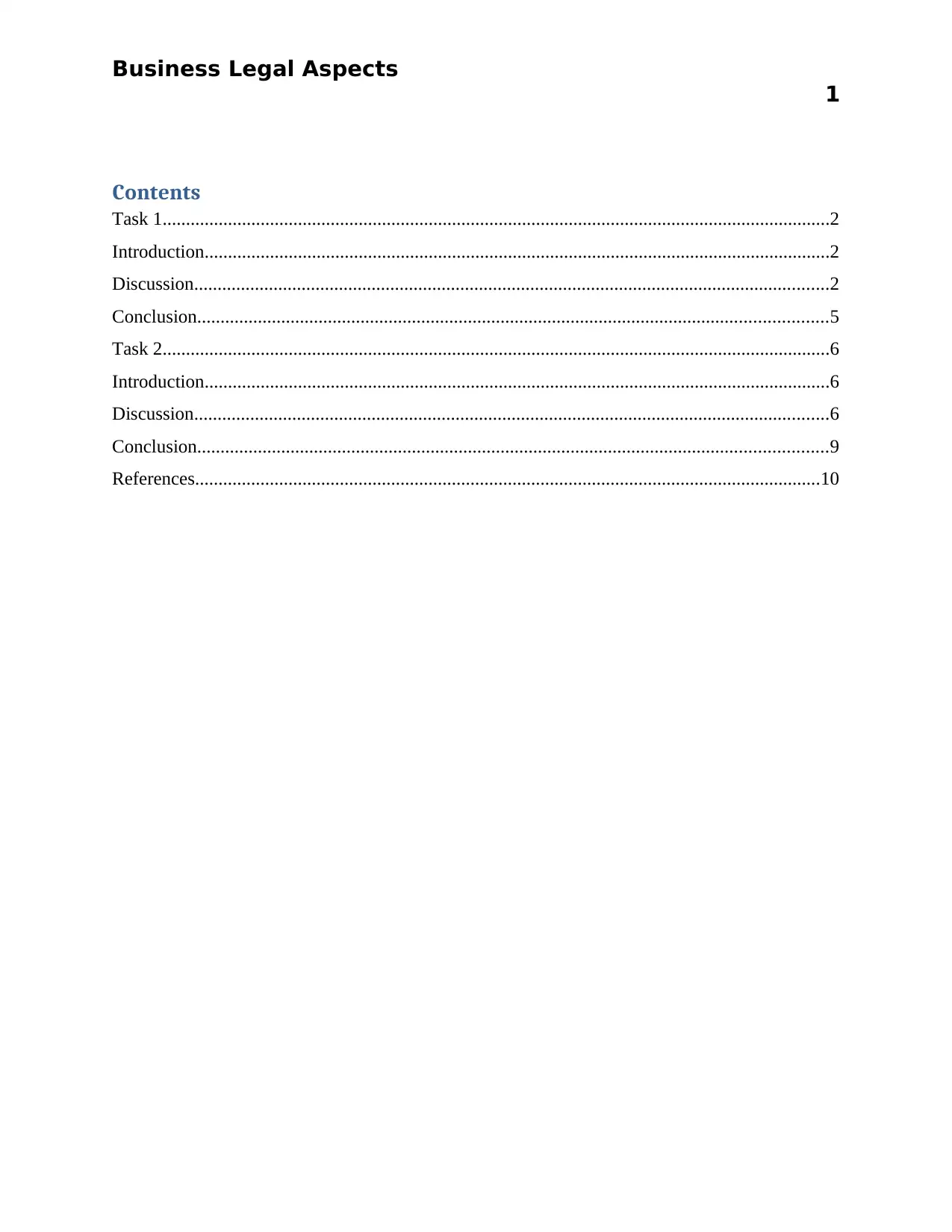
Business Legal Aspects
1
Contents
Task 1...............................................................................................................................................2
Introduction......................................................................................................................................2
Discussion........................................................................................................................................2
Conclusion.......................................................................................................................................5
Task 2...............................................................................................................................................6
Introduction......................................................................................................................................6
Discussion........................................................................................................................................6
Conclusion.......................................................................................................................................9
References......................................................................................................................................10
1
Contents
Task 1...............................................................................................................................................2
Introduction......................................................................................................................................2
Discussion........................................................................................................................................2
Conclusion.......................................................................................................................................5
Task 2...............................................................................................................................................6
Introduction......................................................................................................................................6
Discussion........................................................................................................................................6
Conclusion.......................................................................................................................................9
References......................................................................................................................................10
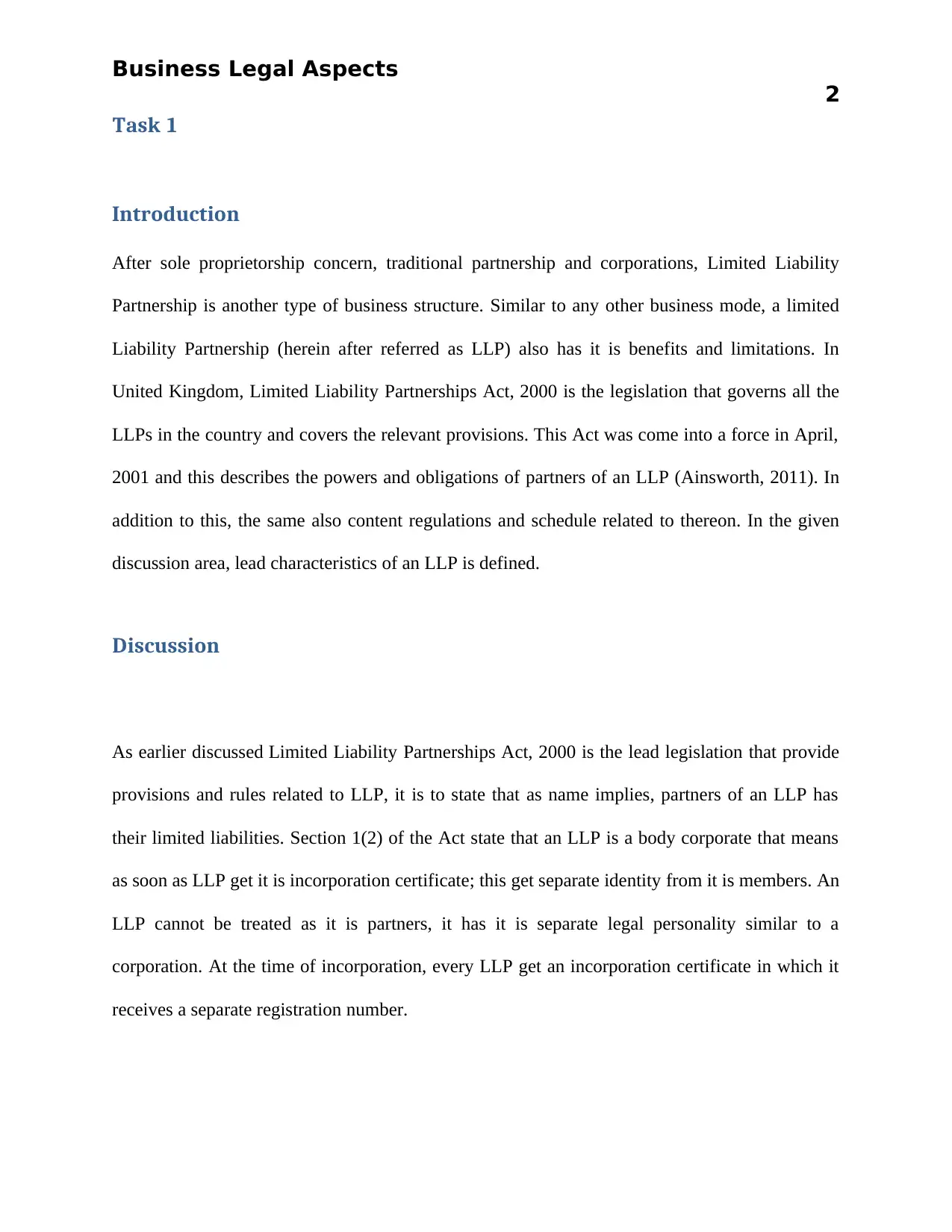
Business Legal Aspects
2
Task 1
Introduction
After sole proprietorship concern, traditional partnership and corporations, Limited Liability
Partnership is another type of business structure. Similar to any other business mode, a limited
Liability Partnership (herein after referred as LLP) also has it is benefits and limitations. In
United Kingdom, Limited Liability Partnerships Act, 2000 is the legislation that governs all the
LLPs in the country and covers the relevant provisions. This Act was come into a force in April,
2001 and this describes the powers and obligations of partners of an LLP (Ainsworth, 2011). In
addition to this, the same also content regulations and schedule related to thereon. In the given
discussion area, lead characteristics of an LLP is defined.
Discussion
As earlier discussed Limited Liability Partnerships Act, 2000 is the lead legislation that provide
provisions and rules related to LLP, it is to state that as name implies, partners of an LLP has
their limited liabilities. Section 1(2) of the Act state that an LLP is a body corporate that means
as soon as LLP get it is incorporation certificate; this get separate identity from it is members. An
LLP cannot be treated as it is partners, it has it is separate legal personality similar to a
corporation. At the time of incorporation, every LLP get an incorporation certificate in which it
receives a separate registration number.
2
Task 1
Introduction
After sole proprietorship concern, traditional partnership and corporations, Limited Liability
Partnership is another type of business structure. Similar to any other business mode, a limited
Liability Partnership (herein after referred as LLP) also has it is benefits and limitations. In
United Kingdom, Limited Liability Partnerships Act, 2000 is the legislation that governs all the
LLPs in the country and covers the relevant provisions. This Act was come into a force in April,
2001 and this describes the powers and obligations of partners of an LLP (Ainsworth, 2011). In
addition to this, the same also content regulations and schedule related to thereon. In the given
discussion area, lead characteristics of an LLP is defined.
Discussion
As earlier discussed Limited Liability Partnerships Act, 2000 is the lead legislation that provide
provisions and rules related to LLP, it is to state that as name implies, partners of an LLP has
their limited liabilities. Section 1(2) of the Act state that an LLP is a body corporate that means
as soon as LLP get it is incorporation certificate; this get separate identity from it is members. An
LLP cannot be treated as it is partners, it has it is separate legal personality similar to a
corporation. At the time of incorporation, every LLP get an incorporation certificate in which it
receives a separate registration number.
⊘ This is a preview!⊘
Do you want full access?
Subscribe today to unlock all pages.

Trusted by 1+ million students worldwide
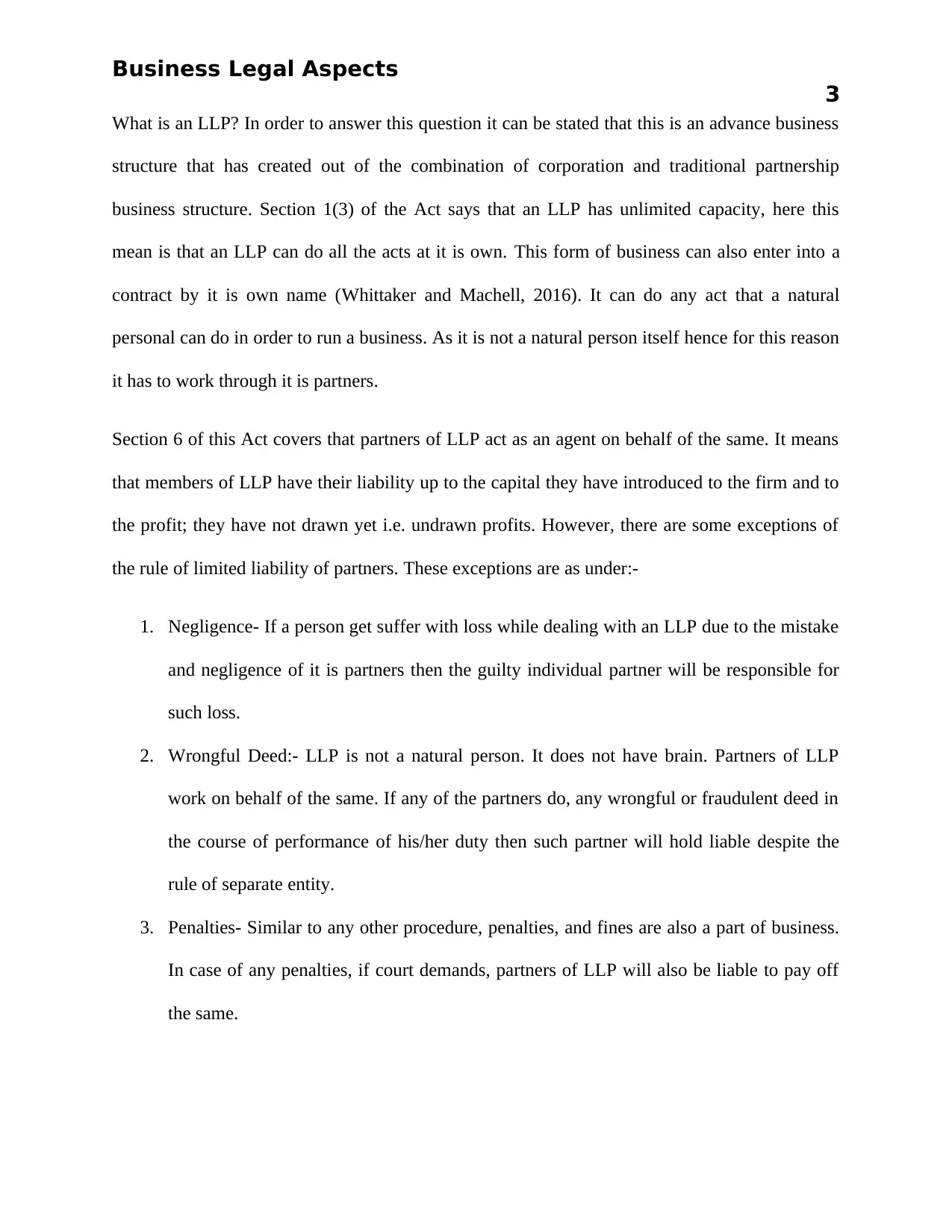
Business Legal Aspects
3
What is an LLP? In order to answer this question it can be stated that this is an advance business
structure that has created out of the combination of corporation and traditional partnership
business structure. Section 1(3) of the Act says that an LLP has unlimited capacity, here this
mean is that an LLP can do all the acts at it is own. This form of business can also enter into a
contract by it is own name (Whittaker and Machell, 2016). It can do any act that a natural
personal can do in order to run a business. As it is not a natural person itself hence for this reason
it has to work through it is partners.
Section 6 of this Act covers that partners of LLP act as an agent on behalf of the same. It means
that members of LLP have their liability up to the capital they have introduced to the firm and to
the profit; they have not drawn yet i.e. undrawn profits. However, there are some exceptions of
the rule of limited liability of partners. These exceptions are as under:-
1. Negligence- If a person get suffer with loss while dealing with an LLP due to the mistake
and negligence of it is partners then the guilty individual partner will be responsible for
such loss.
2. Wrongful Deed:- LLP is not a natural person. It does not have brain. Partners of LLP
work on behalf of the same. If any of the partners do, any wrongful or fraudulent deed in
the course of performance of his/her duty then such partner will hold liable despite the
rule of separate entity.
3. Penalties- Similar to any other procedure, penalties, and fines are also a part of business.
In case of any penalties, if court demands, partners of LLP will also be liable to pay off
the same.
3
What is an LLP? In order to answer this question it can be stated that this is an advance business
structure that has created out of the combination of corporation and traditional partnership
business structure. Section 1(3) of the Act says that an LLP has unlimited capacity, here this
mean is that an LLP can do all the acts at it is own. This form of business can also enter into a
contract by it is own name (Whittaker and Machell, 2016). It can do any act that a natural
personal can do in order to run a business. As it is not a natural person itself hence for this reason
it has to work through it is partners.
Section 6 of this Act covers that partners of LLP act as an agent on behalf of the same. It means
that members of LLP have their liability up to the capital they have introduced to the firm and to
the profit; they have not drawn yet i.e. undrawn profits. However, there are some exceptions of
the rule of limited liability of partners. These exceptions are as under:-
1. Negligence- If a person get suffer with loss while dealing with an LLP due to the mistake
and negligence of it is partners then the guilty individual partner will be responsible for
such loss.
2. Wrongful Deed:- LLP is not a natural person. It does not have brain. Partners of LLP
work on behalf of the same. If any of the partners do, any wrongful or fraudulent deed in
the course of performance of his/her duty then such partner will hold liable despite the
rule of separate entity.
3. Penalties- Similar to any other procedure, penalties, and fines are also a part of business.
In case of any penalties, if court demands, partners of LLP will also be liable to pay off
the same.
Paraphrase This Document
Need a fresh take? Get an instant paraphrase of this document with our AI Paraphraser
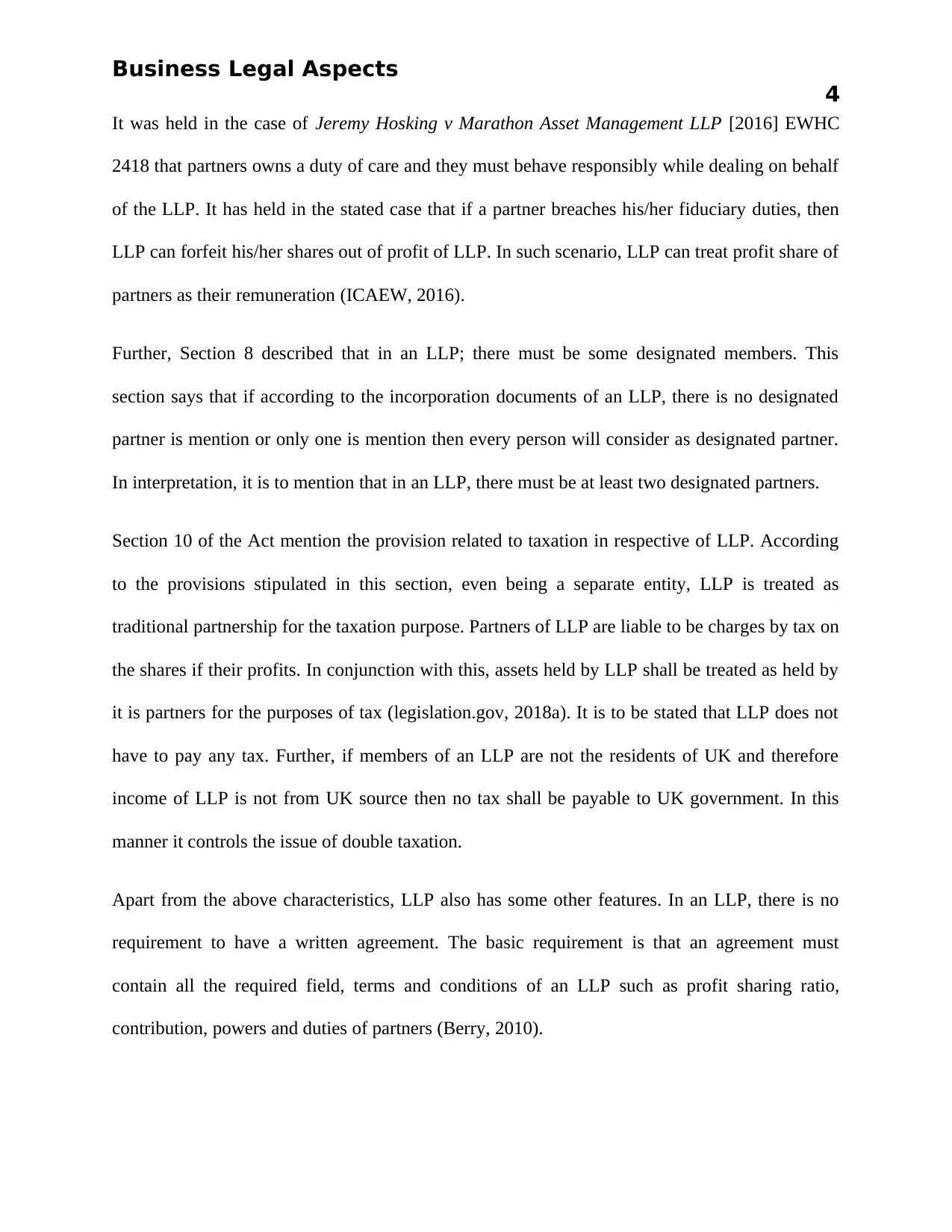
Business Legal Aspects
4
It was held in the case of Jeremy Hosking v Marathon Asset Management LLP [2016] EWHC
2418 that partners owns a duty of care and they must behave responsibly while dealing on behalf
of the LLP. It has held in the stated case that if a partner breaches his/her fiduciary duties, then
LLP can forfeit his/her shares out of profit of LLP. In such scenario, LLP can treat profit share of
partners as their remuneration (ICAEW, 2016).
Further, Section 8 described that in an LLP; there must be some designated members. This
section says that if according to the incorporation documents of an LLP, there is no designated
partner is mention or only one is mention then every person will consider as designated partner.
In interpretation, it is to mention that in an LLP, there must be at least two designated partners.
Section 10 of the Act mention the provision related to taxation in respective of LLP. According
to the provisions stipulated in this section, even being a separate entity, LLP is treated as
traditional partnership for the taxation purpose. Partners of LLP are liable to be charges by tax on
the shares if their profits. In conjunction with this, assets held by LLP shall be treated as held by
it is partners for the purposes of tax (legislation.gov, 2018a). It is to be stated that LLP does not
have to pay any tax. Further, if members of an LLP are not the residents of UK and therefore
income of LLP is not from UK source then no tax shall be payable to UK government. In this
manner it controls the issue of double taxation.
Apart from the above characteristics, LLP also has some other features. In an LLP, there is no
requirement to have a written agreement. The basic requirement is that an agreement must
contain all the required field, terms and conditions of an LLP such as profit sharing ratio,
contribution, powers and duties of partners (Berry, 2010).
4
It was held in the case of Jeremy Hosking v Marathon Asset Management LLP [2016] EWHC
2418 that partners owns a duty of care and they must behave responsibly while dealing on behalf
of the LLP. It has held in the stated case that if a partner breaches his/her fiduciary duties, then
LLP can forfeit his/her shares out of profit of LLP. In such scenario, LLP can treat profit share of
partners as their remuneration (ICAEW, 2016).
Further, Section 8 described that in an LLP; there must be some designated members. This
section says that if according to the incorporation documents of an LLP, there is no designated
partner is mention or only one is mention then every person will consider as designated partner.
In interpretation, it is to mention that in an LLP, there must be at least two designated partners.
Section 10 of the Act mention the provision related to taxation in respective of LLP. According
to the provisions stipulated in this section, even being a separate entity, LLP is treated as
traditional partnership for the taxation purpose. Partners of LLP are liable to be charges by tax on
the shares if their profits. In conjunction with this, assets held by LLP shall be treated as held by
it is partners for the purposes of tax (legislation.gov, 2018a). It is to be stated that LLP does not
have to pay any tax. Further, if members of an LLP are not the residents of UK and therefore
income of LLP is not from UK source then no tax shall be payable to UK government. In this
manner it controls the issue of double taxation.
Apart from the above characteristics, LLP also has some other features. In an LLP, there is no
requirement to have a written agreement. The basic requirement is that an agreement must
contain all the required field, terms and conditions of an LLP such as profit sharing ratio,
contribution, powers and duties of partners (Berry, 2010).
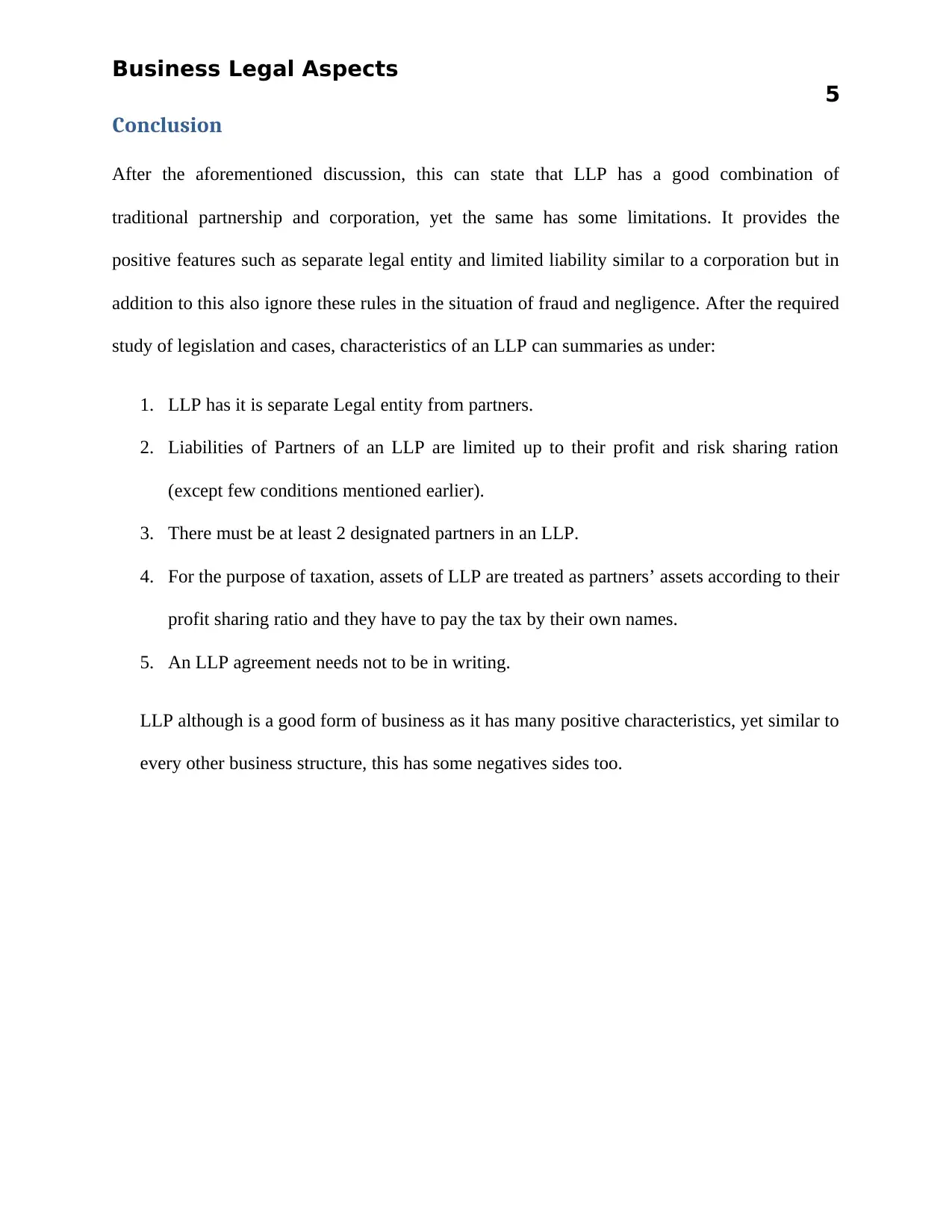
Business Legal Aspects
5
Conclusion
After the aforementioned discussion, this can state that LLP has a good combination of
traditional partnership and corporation, yet the same has some limitations. It provides the
positive features such as separate legal entity and limited liability similar to a corporation but in
addition to this also ignore these rules in the situation of fraud and negligence. After the required
study of legislation and cases, characteristics of an LLP can summaries as under:
1. LLP has it is separate Legal entity from partners.
2. Liabilities of Partners of an LLP are limited up to their profit and risk sharing ration
(except few conditions mentioned earlier).
3. There must be at least 2 designated partners in an LLP.
4. For the purpose of taxation, assets of LLP are treated as partners’ assets according to their
profit sharing ratio and they have to pay the tax by their own names.
5. An LLP agreement needs not to be in writing.
LLP although is a good form of business as it has many positive characteristics, yet similar to
every other business structure, this has some negatives sides too.
5
Conclusion
After the aforementioned discussion, this can state that LLP has a good combination of
traditional partnership and corporation, yet the same has some limitations. It provides the
positive features such as separate legal entity and limited liability similar to a corporation but in
addition to this also ignore these rules in the situation of fraud and negligence. After the required
study of legislation and cases, characteristics of an LLP can summaries as under:
1. LLP has it is separate Legal entity from partners.
2. Liabilities of Partners of an LLP are limited up to their profit and risk sharing ration
(except few conditions mentioned earlier).
3. There must be at least 2 designated partners in an LLP.
4. For the purpose of taxation, assets of LLP are treated as partners’ assets according to their
profit sharing ratio and they have to pay the tax by their own names.
5. An LLP agreement needs not to be in writing.
LLP although is a good form of business as it has many positive characteristics, yet similar to
every other business structure, this has some negatives sides too.
⊘ This is a preview!⊘
Do you want full access?
Subscribe today to unlock all pages.

Trusted by 1+ million students worldwide
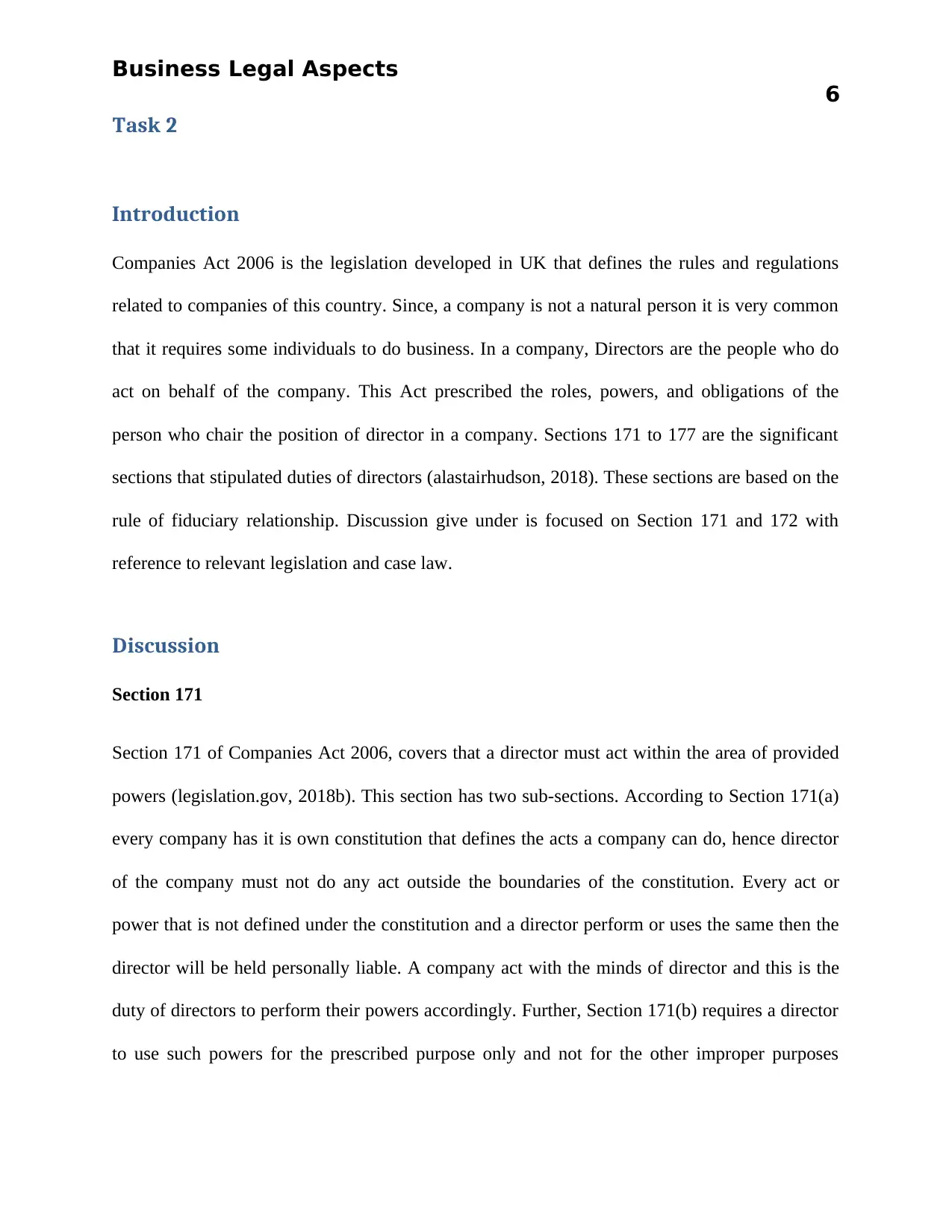
Business Legal Aspects
6
Task 2
Introduction
Companies Act 2006 is the legislation developed in UK that defines the rules and regulations
related to companies of this country. Since, a company is not a natural person it is very common
that it requires some individuals to do business. In a company, Directors are the people who do
act on behalf of the company. This Act prescribed the roles, powers, and obligations of the
person who chair the position of director in a company. Sections 171 to 177 are the significant
sections that stipulated duties of directors (alastairhudson, 2018). These sections are based on the
rule of fiduciary relationship. Discussion give under is focused on Section 171 and 172 with
reference to relevant legislation and case law.
Discussion
Section 171
Section 171 of Companies Act 2006, covers that a director must act within the area of provided
powers (legislation.gov, 2018b). This section has two sub-sections. According to Section 171(a)
every company has it is own constitution that defines the acts a company can do, hence director
of the company must not do any act outside the boundaries of the constitution. Every act or
power that is not defined under the constitution and a director perform or uses the same then the
director will be held personally liable. A company act with the minds of director and this is the
duty of directors to perform their powers accordingly. Further, Section 171(b) requires a director
to use such powers for the prescribed purpose only and not for the other improper purposes
6
Task 2
Introduction
Companies Act 2006 is the legislation developed in UK that defines the rules and regulations
related to companies of this country. Since, a company is not a natural person it is very common
that it requires some individuals to do business. In a company, Directors are the people who do
act on behalf of the company. This Act prescribed the roles, powers, and obligations of the
person who chair the position of director in a company. Sections 171 to 177 are the significant
sections that stipulated duties of directors (alastairhudson, 2018). These sections are based on the
rule of fiduciary relationship. Discussion give under is focused on Section 171 and 172 with
reference to relevant legislation and case law.
Discussion
Section 171
Section 171 of Companies Act 2006, covers that a director must act within the area of provided
powers (legislation.gov, 2018b). This section has two sub-sections. According to Section 171(a)
every company has it is own constitution that defines the acts a company can do, hence director
of the company must not do any act outside the boundaries of the constitution. Every act or
power that is not defined under the constitution and a director perform or uses the same then the
director will be held personally liable. A company act with the minds of director and this is the
duty of directors to perform their powers accordingly. Further, Section 171(b) requires a director
to use such powers for the prescribed purpose only and not for the other improper purposes
Paraphrase This Document
Need a fresh take? Get an instant paraphrase of this document with our AI Paraphraser
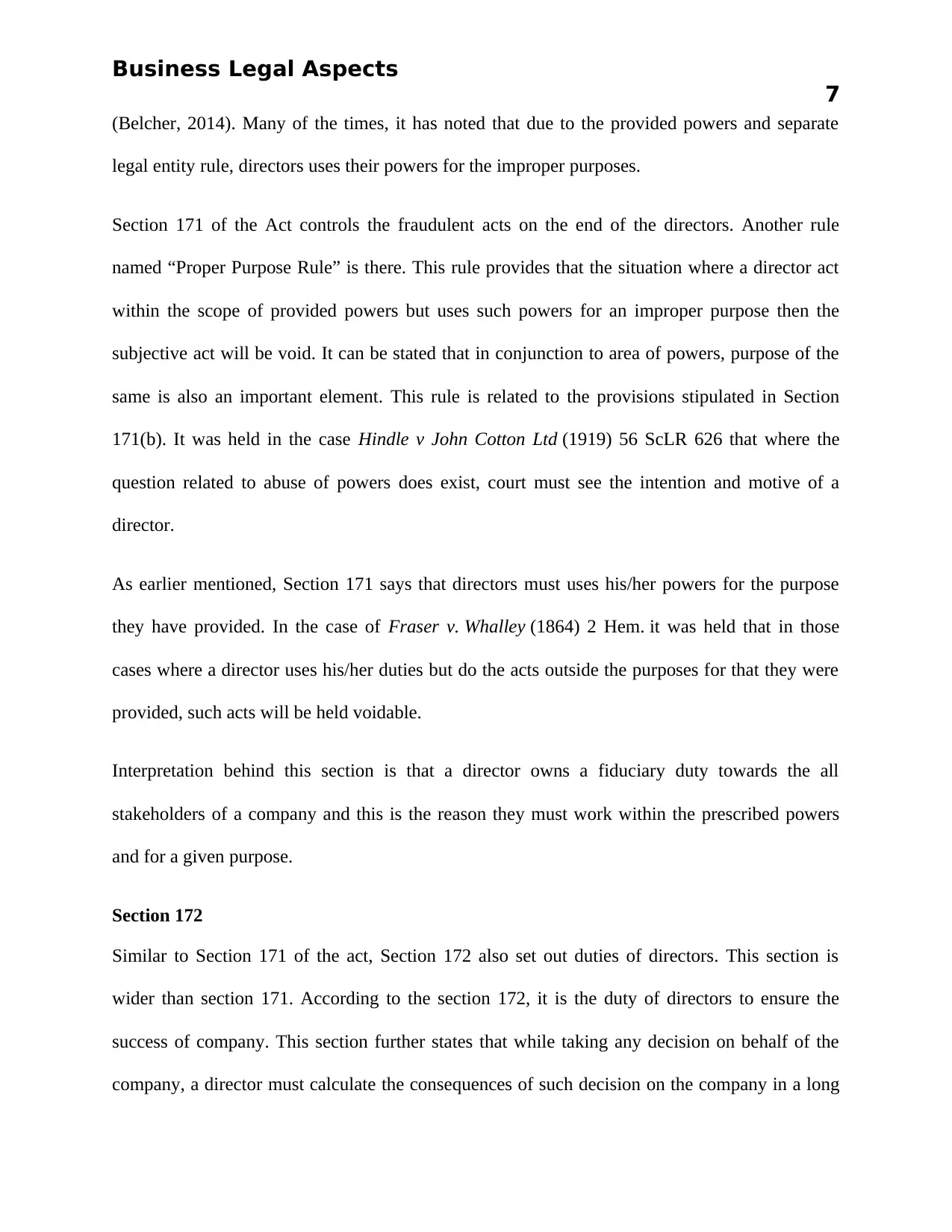
Business Legal Aspects
7
(Belcher, 2014). Many of the times, it has noted that due to the provided powers and separate
legal entity rule, directors uses their powers for the improper purposes.
Section 171 of the Act controls the fraudulent acts on the end of the directors. Another rule
named “Proper Purpose Rule” is there. This rule provides that the situation where a director act
within the scope of provided powers but uses such powers for an improper purpose then the
subjective act will be void. It can be stated that in conjunction to area of powers, purpose of the
same is also an important element. This rule is related to the provisions stipulated in Section
171(b). It was held in the case Hindle v John Cotton Ltd (1919) 56 ScLR 626 that where the
question related to abuse of powers does exist, court must see the intention and motive of a
director.
As earlier mentioned, Section 171 says that directors must uses his/her powers for the purpose
they have provided. In the case of Fraser v. Whalley (1864) 2 Hem. it was held that in those
cases where a director uses his/her duties but do the acts outside the purposes for that they were
provided, such acts will be held voidable.
Interpretation behind this section is that a director owns a fiduciary duty towards the all
stakeholders of a company and this is the reason they must work within the prescribed powers
and for a given purpose.
Section 172
Similar to Section 171 of the act, Section 172 also set out duties of directors. This section is
wider than section 171. According to the section 172, it is the duty of directors to ensure the
success of company. This section further states that while taking any decision on behalf of the
company, a director must calculate the consequences of such decision on the company in a long
7
(Belcher, 2014). Many of the times, it has noted that due to the provided powers and separate
legal entity rule, directors uses their powers for the improper purposes.
Section 171 of the Act controls the fraudulent acts on the end of the directors. Another rule
named “Proper Purpose Rule” is there. This rule provides that the situation where a director act
within the scope of provided powers but uses such powers for an improper purpose then the
subjective act will be void. It can be stated that in conjunction to area of powers, purpose of the
same is also an important element. This rule is related to the provisions stipulated in Section
171(b). It was held in the case Hindle v John Cotton Ltd (1919) 56 ScLR 626 that where the
question related to abuse of powers does exist, court must see the intention and motive of a
director.
As earlier mentioned, Section 171 says that directors must uses his/her powers for the purpose
they have provided. In the case of Fraser v. Whalley (1864) 2 Hem. it was held that in those
cases where a director uses his/her duties but do the acts outside the purposes for that they were
provided, such acts will be held voidable.
Interpretation behind this section is that a director owns a fiduciary duty towards the all
stakeholders of a company and this is the reason they must work within the prescribed powers
and for a given purpose.
Section 172
Similar to Section 171 of the act, Section 172 also set out duties of directors. This section is
wider than section 171. According to the section 172, it is the duty of directors to ensure the
success of company. This section further states that while taking any decision on behalf of the
company, a director must calculate the consequences of such decision on the company in a long
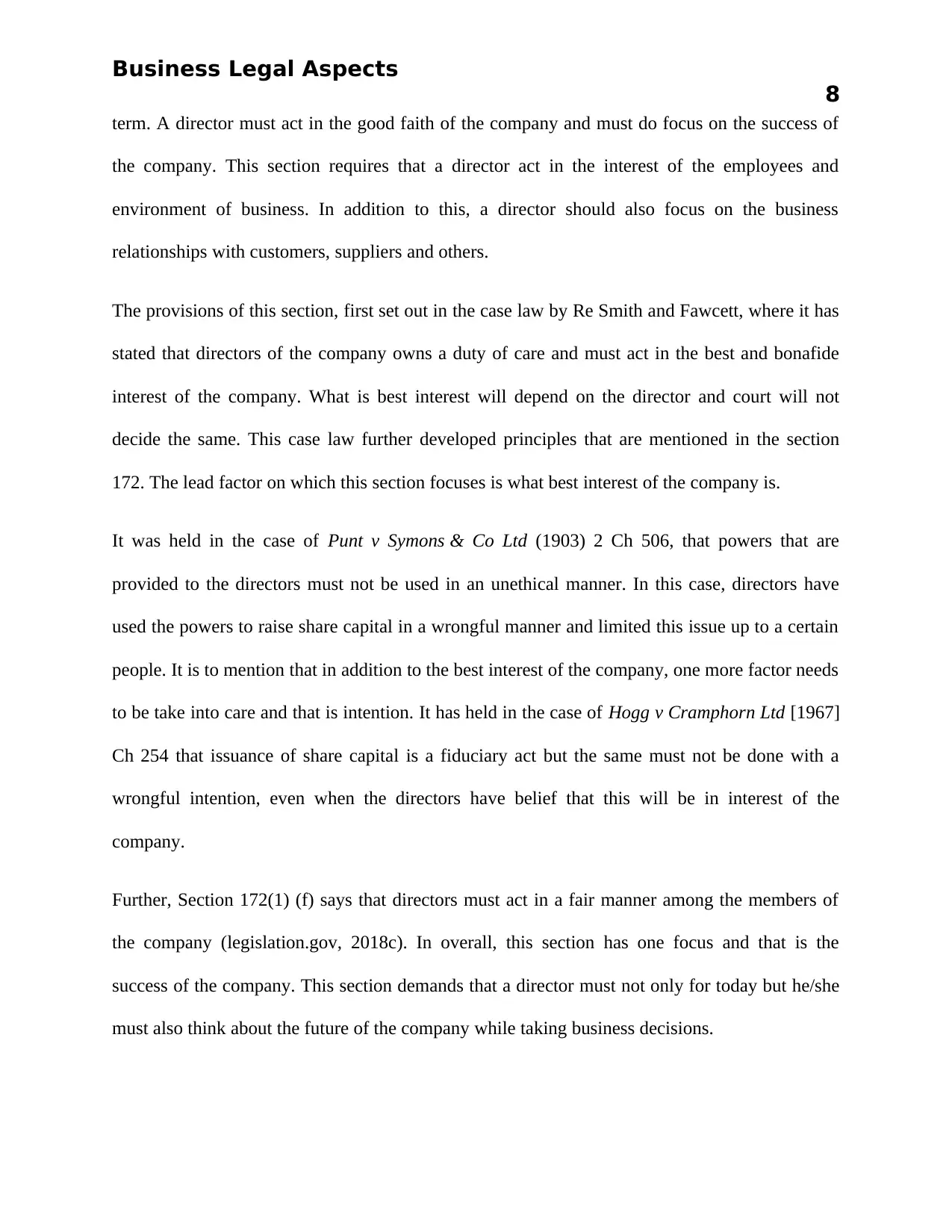
Business Legal Aspects
8
term. A director must act in the good faith of the company and must do focus on the success of
the company. This section requires that a director act in the interest of the employees and
environment of business. In addition to this, a director should also focus on the business
relationships with customers, suppliers and others.
The provisions of this section, first set out in the case law by Re Smith and Fawcett, where it has
stated that directors of the company owns a duty of care and must act in the best and bonafide
interest of the company. What is best interest will depend on the director and court will not
decide the same. This case law further developed principles that are mentioned in the section
172. The lead factor on which this section focuses is what best interest of the company is.
It was held in the case of Punt v Symons & Co Ltd (1903) 2 Ch 506, that powers that are
provided to the directors must not be used in an unethical manner. In this case, directors have
used the powers to raise share capital in a wrongful manner and limited this issue up to a certain
people. It is to mention that in addition to the best interest of the company, one more factor needs
to be take into care and that is intention. It has held in the case of Hogg v Cramphorn Ltd [1967]
Ch 254 that issuance of share capital is a fiduciary act but the same must not be done with a
wrongful intention, even when the directors have belief that this will be in interest of the
company.
Further, Section 172(1) (f) says that directors must act in a fair manner among the members of
the company (legislation.gov, 2018c). In overall, this section has one focus and that is the
success of the company. This section demands that a director must not only for today but he/she
must also think about the future of the company while taking business decisions.
8
term. A director must act in the good faith of the company and must do focus on the success of
the company. This section requires that a director act in the interest of the employees and
environment of business. In addition to this, a director should also focus on the business
relationships with customers, suppliers and others.
The provisions of this section, first set out in the case law by Re Smith and Fawcett, where it has
stated that directors of the company owns a duty of care and must act in the best and bonafide
interest of the company. What is best interest will depend on the director and court will not
decide the same. This case law further developed principles that are mentioned in the section
172. The lead factor on which this section focuses is what best interest of the company is.
It was held in the case of Punt v Symons & Co Ltd (1903) 2 Ch 506, that powers that are
provided to the directors must not be used in an unethical manner. In this case, directors have
used the powers to raise share capital in a wrongful manner and limited this issue up to a certain
people. It is to mention that in addition to the best interest of the company, one more factor needs
to be take into care and that is intention. It has held in the case of Hogg v Cramphorn Ltd [1967]
Ch 254 that issuance of share capital is a fiduciary act but the same must not be done with a
wrongful intention, even when the directors have belief that this will be in interest of the
company.
Further, Section 172(1) (f) says that directors must act in a fair manner among the members of
the company (legislation.gov, 2018c). In overall, this section has one focus and that is the
success of the company. This section demands that a director must not only for today but he/she
must also think about the future of the company while taking business decisions.
⊘ This is a preview!⊘
Do you want full access?
Subscribe today to unlock all pages.

Trusted by 1+ million students worldwide
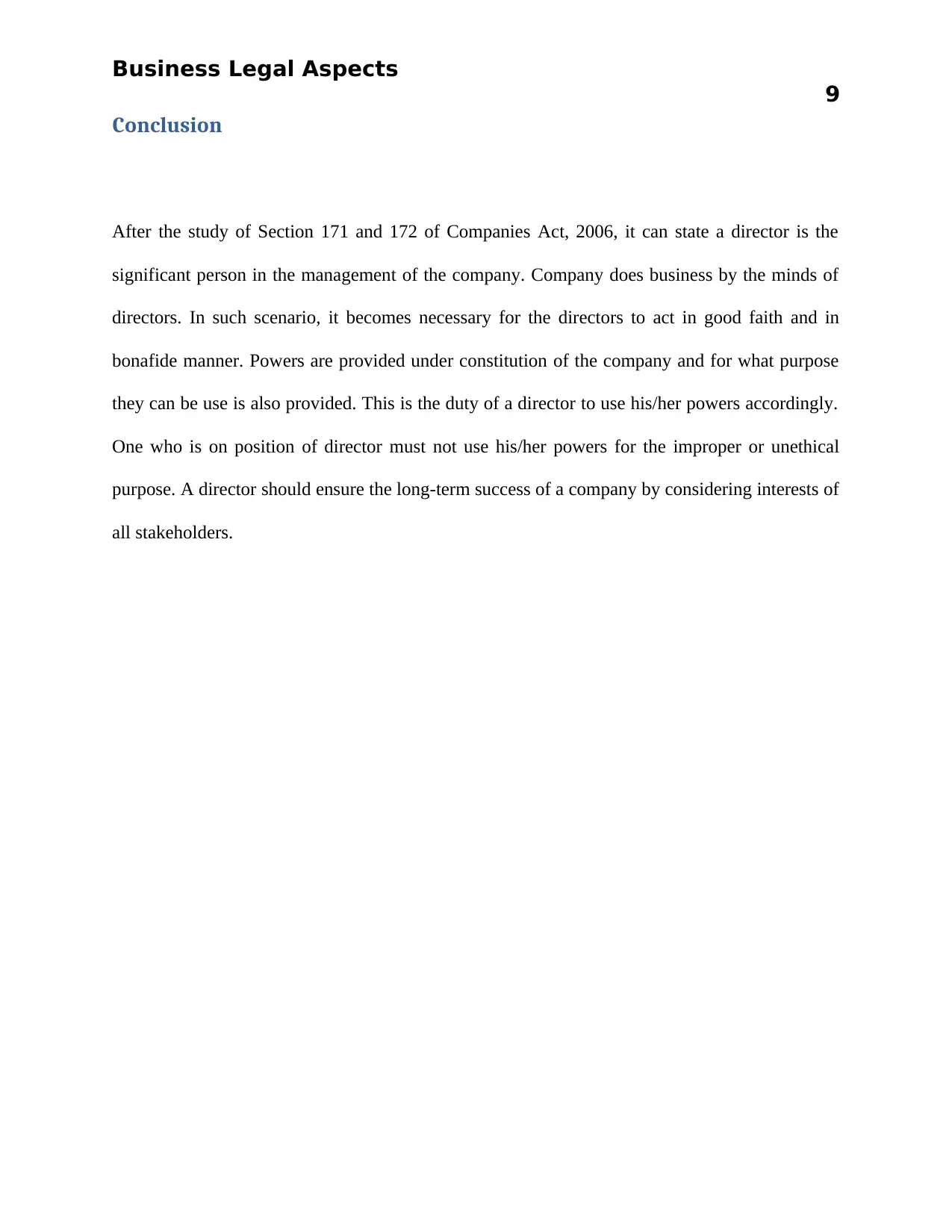
Business Legal Aspects
9
Conclusion
After the study of Section 171 and 172 of Companies Act, 2006, it can state a director is the
significant person in the management of the company. Company does business by the minds of
directors. In such scenario, it becomes necessary for the directors to act in good faith and in
bonafide manner. Powers are provided under constitution of the company and for what purpose
they can be use is also provided. This is the duty of a director to use his/her powers accordingly.
One who is on position of director must not use his/her powers for the improper or unethical
purpose. A director should ensure the long-term success of a company by considering interests of
all stakeholders.
9
Conclusion
After the study of Section 171 and 172 of Companies Act, 2006, it can state a director is the
significant person in the management of the company. Company does business by the minds of
directors. In such scenario, it becomes necessary for the directors to act in good faith and in
bonafide manner. Powers are provided under constitution of the company and for what purpose
they can be use is also provided. This is the duty of a director to use his/her powers accordingly.
One who is on position of director must not use his/her powers for the improper or unethical
purpose. A director should ensure the long-term success of a company by considering interests of
all stakeholders.
Paraphrase This Document
Need a fresh take? Get an instant paraphrase of this document with our AI Paraphraser
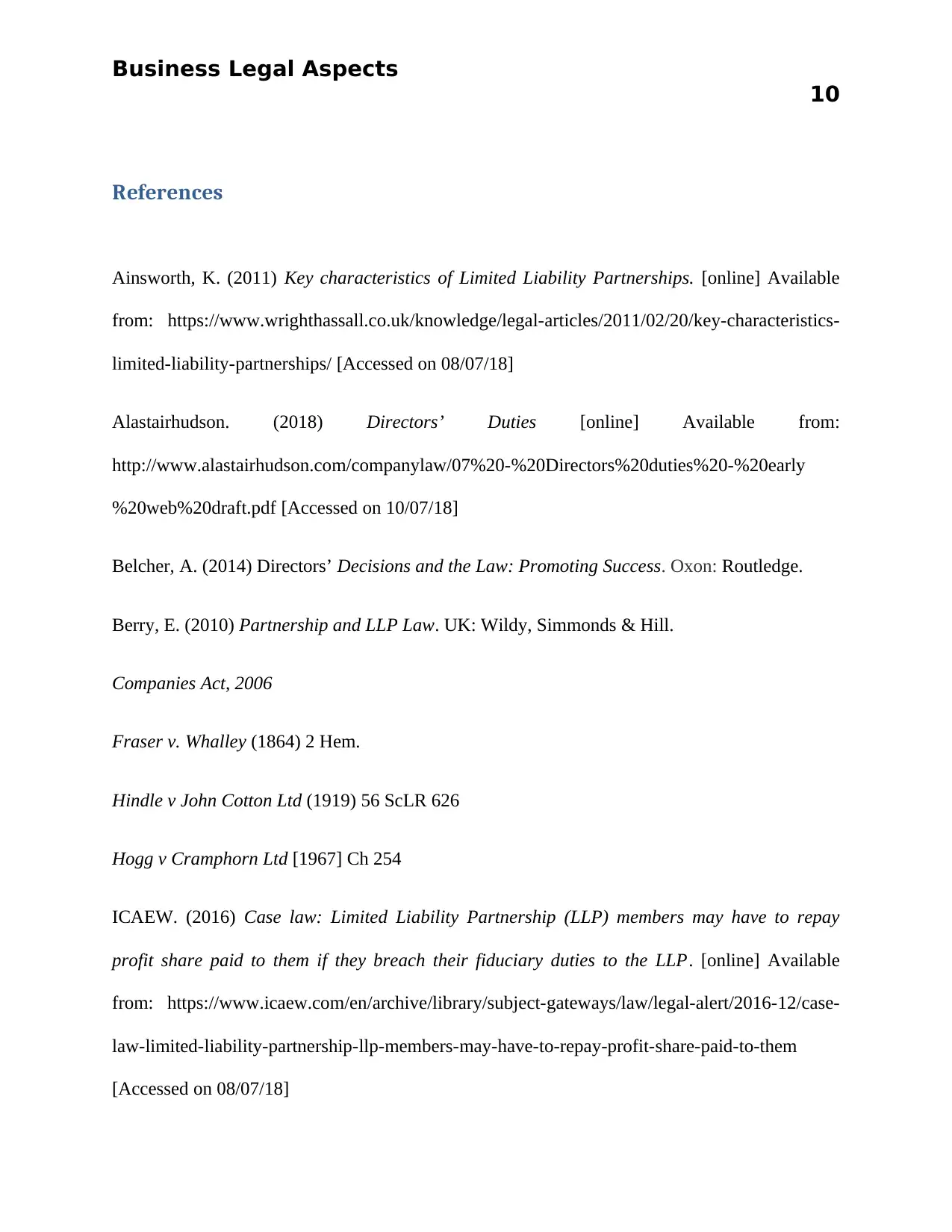
Business Legal Aspects
10
References
Ainsworth, K. (2011) Key characteristics of Limited Liability Partnerships. [online] Available
from: https://www.wrighthassall.co.uk/knowledge/legal-articles/2011/02/20/key-characteristics-
limited-liability-partnerships/ [Accessed on 08/07/18]
Alastairhudson. (2018) Directors’ Duties [online] Available from:
http://www.alastairhudson.com/companylaw/07%20-%20Directors%20duties%20-%20early
%20web%20draft.pdf [Accessed on 10/07/18]
Belcher, A. (2014) Directors’ Decisions and the Law: Promoting Success. Oxon: Routledge.
Berry, E. (2010) Partnership and LLP Law. UK: Wildy, Simmonds & Hill.
Companies Act, 2006
Fraser v. Whalley (1864) 2 Hem.
Hindle v John Cotton Ltd (1919) 56 ScLR 626
Hogg v Cramphorn Ltd [1967] Ch 254
ICAEW. (2016) Case law: Limited Liability Partnership (LLP) members may have to repay
profit share paid to them if they breach their fiduciary duties to the LLP. [online] Available
from: https://www.icaew.com/en/archive/library/subject-gateways/law/legal-alert/2016-12/case-
law-limited-liability-partnership-llp-members-may-have-to-repay-profit-share-paid-to-them
[Accessed on 08/07/18]
10
References
Ainsworth, K. (2011) Key characteristics of Limited Liability Partnerships. [online] Available
from: https://www.wrighthassall.co.uk/knowledge/legal-articles/2011/02/20/key-characteristics-
limited-liability-partnerships/ [Accessed on 08/07/18]
Alastairhudson. (2018) Directors’ Duties [online] Available from:
http://www.alastairhudson.com/companylaw/07%20-%20Directors%20duties%20-%20early
%20web%20draft.pdf [Accessed on 10/07/18]
Belcher, A. (2014) Directors’ Decisions and the Law: Promoting Success. Oxon: Routledge.
Berry, E. (2010) Partnership and LLP Law. UK: Wildy, Simmonds & Hill.
Companies Act, 2006
Fraser v. Whalley (1864) 2 Hem.
Hindle v John Cotton Ltd (1919) 56 ScLR 626
Hogg v Cramphorn Ltd [1967] Ch 254
ICAEW. (2016) Case law: Limited Liability Partnership (LLP) members may have to repay
profit share paid to them if they breach their fiduciary duties to the LLP. [online] Available
from: https://www.icaew.com/en/archive/library/subject-gateways/law/legal-alert/2016-12/case-
law-limited-liability-partnership-llp-members-may-have-to-repay-profit-share-paid-to-them
[Accessed on 08/07/18]
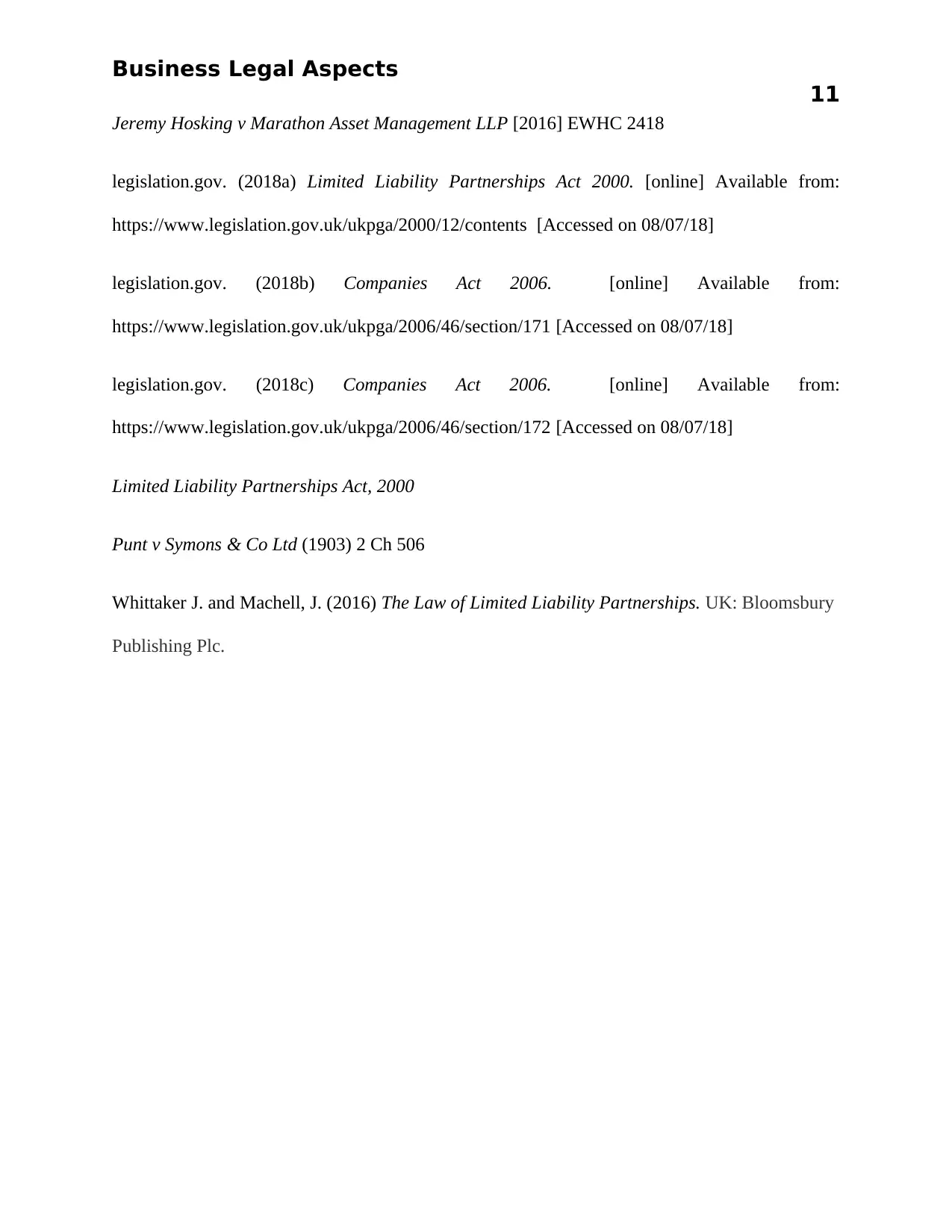
Business Legal Aspects
11
Jeremy Hosking v Marathon Asset Management LLP [2016] EWHC 2418
legislation.gov. (2018a) Limited Liability Partnerships Act 2000. [online] Available from:
https://www.legislation.gov.uk/ukpga/2000/12/contents [Accessed on 08/07/18]
legislation.gov. (2018b) Companies Act 2006. [online] Available from:
https://www.legislation.gov.uk/ukpga/2006/46/section/171 [Accessed on 08/07/18]
legislation.gov. (2018c) Companies Act 2006. [online] Available from:
https://www.legislation.gov.uk/ukpga/2006/46/section/172 [Accessed on 08/07/18]
Limited Liability Partnerships Act, 2000
Punt v Symons & Co Ltd (1903) 2 Ch 506
Whittaker J. and Machell, J. (2016) The Law of Limited Liability Partnerships. UK: Bloomsbury
Publishing Plc.
11
Jeremy Hosking v Marathon Asset Management LLP [2016] EWHC 2418
legislation.gov. (2018a) Limited Liability Partnerships Act 2000. [online] Available from:
https://www.legislation.gov.uk/ukpga/2000/12/contents [Accessed on 08/07/18]
legislation.gov. (2018b) Companies Act 2006. [online] Available from:
https://www.legislation.gov.uk/ukpga/2006/46/section/171 [Accessed on 08/07/18]
legislation.gov. (2018c) Companies Act 2006. [online] Available from:
https://www.legislation.gov.uk/ukpga/2006/46/section/172 [Accessed on 08/07/18]
Limited Liability Partnerships Act, 2000
Punt v Symons & Co Ltd (1903) 2 Ch 506
Whittaker J. and Machell, J. (2016) The Law of Limited Liability Partnerships. UK: Bloomsbury
Publishing Plc.
⊘ This is a preview!⊘
Do you want full access?
Subscribe today to unlock all pages.

Trusted by 1+ million students worldwide
1 out of 12
Related Documents
Your All-in-One AI-Powered Toolkit for Academic Success.
+13062052269
info@desklib.com
Available 24*7 on WhatsApp / Email
![[object Object]](/_next/static/media/star-bottom.7253800d.svg)
Unlock your academic potential
Copyright © 2020–2025 A2Z Services. All Rights Reserved. Developed and managed by ZUCOL.

